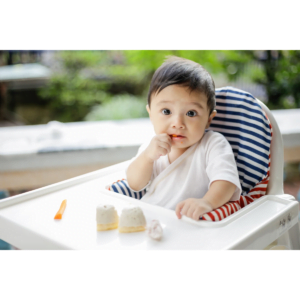How To Develop Self-Feeding And Eating Skills
- Published on:
- Last update: 13 November 2023

Baby feeding tips
It is certainly one of the most common questions I get here at the office: “How can I get my child to eat by themselves?” Parents who are tired are thrilled when their children self-feed! Since I could sit back and enjoy my own meal again, I was pretty motivated to teach my own children. As you know, it is very important that your baby eats well. We can help them to learn how to feed themselves, but first, they need some basic skills. Here are some specifics of baby feeding tips.
How to Teach Self-Feeding
Here’s a complete guide to baby feeding tips that covers it all for you. Below are the steps I will take in teaching your child how to:
- finger feed
- eat with a spoon
- eat with a fork
All of these are actually separate skills, each of which is typically acquired at a different age. In addition to sharing the best utensils for babies and toddlers, I will discuss the best ways to self-feed! Ready? Start reading!

How to Teach Your Child to Self-Feed with their Fingers
It is expected that by 8 months, your child will start eating those little melt-able puffs right off their tray. You will initially notice that they grasp their food with their whole hand in the form of a rake. A lot of time they will try to shove their entire hand into their mouth at once after getting a bunch in their hand.
Though ineffective, this method still works. With time, they will begin to use several fingers to pick up more foods, which will eventually evolve into a pincer grip. By grasping with pincers, children lay the foundation for fine motor skills such as writing in the future.
Baby feeding tips: How To Teach Self-feeding!
To begin with, make sure you are giving them the chance. Let them try again and again, it’s alright to let them struggle sometimes. Learning comes from struggles! Puffs like these should be dry and big enough for them to pick up, but not so big that they can choke.
As well as these cheese curls and pea crisps designed for babies, I like to break them up into small pieces. In general, most kids are motivated to eat, and they’ll figure out how to consume it. With the pincer grasp, there is sometimes a problem.
Provide them with one piece of food at a time at the beginning of their meal if they are not isolating their fingers and thumbs. It may help to place one puff on their tray first, without a boatload of puffs, then they may isolate those fingers for you. You should hold the object up in front of them, as my husband is doing in the picture above if they refuse to use a pincer grasp.
Wait until you see them grasping it with their index finger and thumb before you let go. Let them finish their meal normally after spending a few minutes practising during the beginning of the meal. They will surely master this new skill soon enough!
When will your toddler start eating with a spoon?
Children should be able to feed themselves with a spoon, completely independently, by the age of two. In reality, most children are capable of learning way younger than that if they are given the opportunity. After one year, they are capable of feeding themselves proficiently and messily. You should let your kid get messy when eating.
Teaching Your Toddler (or Baby) to Self-Feed with a Spoon

You need to let your baby or toddler try spoon feeding at first like with self-feeding. It is very important that you give your baby their own spoon while you feed them in the very early days of feeding them. By doing so, the baby gets to associate the spoon with eating and gets to develop some fine motor skills in the process.
Your child should put it intermittently to their mouth, so encourage them to do so. Once they begin to bite into the food, place your hand on top of theirs and dip together in the food. Put just enough on the spoon to make sure they only taste a little bit. Continue doing this several times while they eat until they eventually get the hang of it.
With that learned, it is time to provide them with their own little bowl when you feed them. I can already feel where the panic is setting in for so many of you – What, their own bowl?!? Are they going to throw that into their mouths or stick their hands in it? Of course, I suggest that!
It will keep them from throwing the whole bowl on the floor if they use the suction bowls. Whenever possible, they should be fed little bits at a time. You will still be feeding them most of the meal at this point. Putting more food into the bowl for them to eat as they are doing well at scooping up food and getting some into their mouths. Take your time with these baby feeding tips.
Putting a hand over theirs and moving through the steps of scooping and putting the bite into their mouth can help if they don’t show much interest or are having trouble manipulating the spoon. Depending on how long ago you started feeding your child baby food, your child is likely between 8 and 9 months old by this time.
It’s okay to gently remind them that food goes in their mouth if the mess becomes too distracting, which is likely to happen. Make sure you understand that the mess and playing with food is all part of the process. It may be challenging, but it is temporary.
The Best Way to Encourage a Toddler to Self-Feed

If your child is already a toddler and you missed the steps I just described, it is okay. You still need to follow pretty much the same baby feeding tips as I described. It is quite likely that you will be able to move faster through those early steps.
Many parents don’t think of giving their child a spoon at such a young age, or they are overwhelmed by how much mess it makes. You should follow a toddler’s lead when it comes to giving them as much help as they need, but it’s okay to let them struggle a little here, too. You need to be consistent in the number of spoons you present to them and be patient!
With tasty, healthy food from Yummy Valley, self-feeding is made easier.
Share this post:

